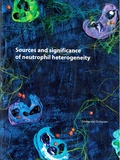Sources and significance of neutrophil heterogeneity

Grinsven, Erinke van
- Promoter:
- Prof.dr. L. (Leo) Koenderman
- Co-promoter:
- Dr. N. (Nienke) Vrisekoop
- Research group:
- Koenderman
- Date:
- April 10, 2019
- Time:
- 12:45 h
Summary
The neutrophil is a white blood cell indispensable for the human defense against pathogenic bacteria and fungi. However, if this cell aims its antimicrobial weapons at healthy tissue, it will afflict severe damage to the human body. Hence, where, when, and how neutrophils are activated is finely balanced to keep the body healthy. It has long been thought that every neutrophil is similar and that every neutrophil responds similarly to an activating signal. However, recent research has discovered various subtypes of the neutrophil. To understand how we can restore a healthy balance, we first need to understand where and when each neutrophil subtype appears and what its function is.
The thesis “Sources and significance of neutrophil heterogeneity” by Erinke van Grinsven provides insight in the where, when, and what. She describes how different subtypes of neutrophils could contribute to the outcome of infection and inflammation. Her research demonstrated that neutrophil subtypes migrate with different speeds through human tissues towards pathogens, and that they respond differently to the ingestion of pathogens. Furthermore she studied the human bone marrow as the factory for new neutrophils. She quantified the neutrophil production and their lifespan in the blood in healthy subjects.
In the future this new knowledge will hopefully lead to new therapies that activate or inhibit a specific neutrophil subtype at a specific location or time point, to treat a range of infections and immune diseases.